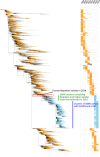Characterization of influenza A(H1N1)pdm09 viruses isolated from Nepalese and Indian outbreak patients in early 2015
- PMID: 28792671
- PMCID: PMC5596518
- DOI: 10.1111/irv.12469
Characterization of influenza A(H1N1)pdm09 viruses isolated from Nepalese and Indian outbreak patients in early 2015
Abstract
We characterized influenza A(H1N1)pdm09 isolates from large-scale outbreaks that occurred in Nepal and India in early 2015. Although no specific viral features, which may have caused the outbreaks, were identified, an S84N substitution in hemagglutinin was frequently observed. Chronological phylogenetic analysis revealed that these Nepalese and Indian viruses possessing the S84N substitution constitute potential ancestors of the novel genetic subclade 6B.1 virus that spread globally in the following (2015/16) influenza season. Thus, active surveillance of circulating influenza viruses in the Southern Asia region, including Nepal and India, would be beneficial for detecting novel variant viruses prior to their worldwide spread.
Keywords: India; Nepal; influenza A(H1N1)pdm09 virus; outbreak.
© 2017 The Authors. Influenza and Other Respiratory Viruses Published by John Wiley & Sons Ltd.
Figures


Similar articles
-
Genetic characterisation of influenza A(H1N1)pdm09 viruses circulating in Assam, Northeast India during 2009-2015.Indian J Med Microbiol. 2019 Jan-Mar;37(1):42-49. doi: 10.4103/ijmm.IJMM_18_416. Indian J Med Microbiol. 2019. PMID: 31424009
-
Molecular characterization of the influenza A(H1N1)pdm09 isolates collected in the 2015-2016 season and comparison of HA mutations detected in Turkey since 2009.J Med Virol. 2019 Dec;91(12):2074-2082. doi: 10.1002/jmv.25565. Epub 2019 Aug 20. J Med Virol. 2019. PMID: 31389035
-
Molecular epidemiology of the hemagglutinin gene of prevalent influenza virus A/H1N1/pdm09 among patient in Iran.Virus Res. 2019 Jan 2;259:38-45. doi: 10.1016/j.virusres.2018.10.001. Epub 2018 Oct 15. Virus Res. 2019. PMID: 30336188
-
Genetic Characterization of Circulating 2015 A(H1N1)pdm09 Influenza Viruses from Eastern India.PLoS One. 2016 Dec 20;11(12):e0168464. doi: 10.1371/journal.pone.0168464. eCollection 2016. PLoS One. 2016. PMID: 27997573 Free PMC article.
-
Towards a sane and rational approach to management of Influenza H1N1 2009.Virol J. 2009 May 7;6:51. doi: 10.1186/1743-422X-6-51. Virol J. 2009. PMID: 19422701 Free PMC article. Review.
Cited by
-
Adaptive Mutations in Influenza A/California/07/2009 Enhance Polymerase Activity and Infectious Virion Production.Viruses. 2018 May 18;10(5):272. doi: 10.3390/v10050272. Viruses. 2018. PMID: 29783694 Free PMC article.
-
Phylodynamics of Influenza A/H1N1pdm09 in India Reveals Circulation Patterns and Increased Selection for Clade 6b Residues and Other High Mortality Mutants.Viruses. 2019 Aug 27;11(9):791. doi: 10.3390/v11090791. Viruses. 2019. PMID: 31462006 Free PMC article.
-
Epidemic of influenza A(H1N1)pdm09 analyzed by full genome sequences and the first case of oseltamivir-resistant strain in Myanmar 2017.PLoS One. 2020 Mar 4;15(3):e0229601. doi: 10.1371/journal.pone.0229601. eCollection 2020. PLoS One. 2020. PMID: 32130243 Free PMC article.
-
Differential disease severity and whole-genome sequence analysis for human influenza A/H1N1pdm virus in 2015-2016 influenza season.Virus Evol. 2021 May 18;7(1):veab044. doi: 10.1093/ve/veab044. eCollection 2021 Jan. Virus Evol. 2021. PMID: 34040796 Free PMC article.
-
Molecular epidemiology survey and characterization of human influenza A viruses circulating among Palestinians in East Jerusalem and the West Bank in 2015.PLoS One. 2019 Mar 8;14(3):e0213290. doi: 10.1371/journal.pone.0213290. eCollection 2019. PLoS One. 2019. PMID: 30849093 Free PMC article.
References
-
- Bagchi S. India tackles H1N1 influenza outbreak. Lancet. 2015;385:e21. - PubMed
-
- D'Silva J. Swine flu: how well did India respond? BMJ. 2015;350:h2286. - PubMed
-
- World Health Organization . Influenza surveillance report. https://extranet.who.int/sree/Reports?op=vs&path=/WHO_HQ_Reports/G5/PROD.... Accessed December 10, 2015.
-
- Tharakaraman K, Sasisekharan R. Influenza surveillance: 2014‐2015 H1N1 “swine”‐derived influenza viruses from India. Cell Host Microbe. 2015;17:279‐282. - PubMed
Publication types
MeSH terms
Substances
Grants and funding
LinkOut - more resources
Full Text Sources
Other Literature Sources
Medical

